Please enter your email in order to download this publication.
By Marc Effron, President, Talent Strategy Group
After the most challenging period in business in a century, many companies can start to focus their attention more than a few days in the future. This turn towards normalcy raises questions about how to manage and reward performance in such an unprecedented year.
We suggest that there are no clear rules but that there is a logical approach that can guide how to best (re)-set goals and fairly evaluate at the end of the performance cycle.
This logical approach means that your executives should not reflexively apply solutions they may have read about in the business media. For example, Facebook announced on March 17, 2020 that it would assign every employee an “exceeds expectations” rating for the first half of 2020. While this may have sounded to some like every Facebook employee received the highest rating, their highest performance rating is “redefines,” followed by “greatly exceeds expectations” and then “exceeds expectations.”
The company will also maintain its rigorous process of gathering feedback from peers and others as input to performance reviews. So, Facebook did not give every employee a “pass” for their performance for the first half of 2020.
Similarly, Google postponed their “Perf” review process for 6 months in 2020, saying that they needed to focus on the “most important, mission-critical activities.” That was the right choice for Google but, unless your company is also Google, their choice should not influence how you approach performance management.
What Should Change (If Anything)
It may seem obvious that performance management should fundamentally change given recent events. We suggest that’s an incorrect assumption. Companies must decide if enough has changed in their operating environment to justify a change in how they operationalize performance management and, if it has, how performance management should change.
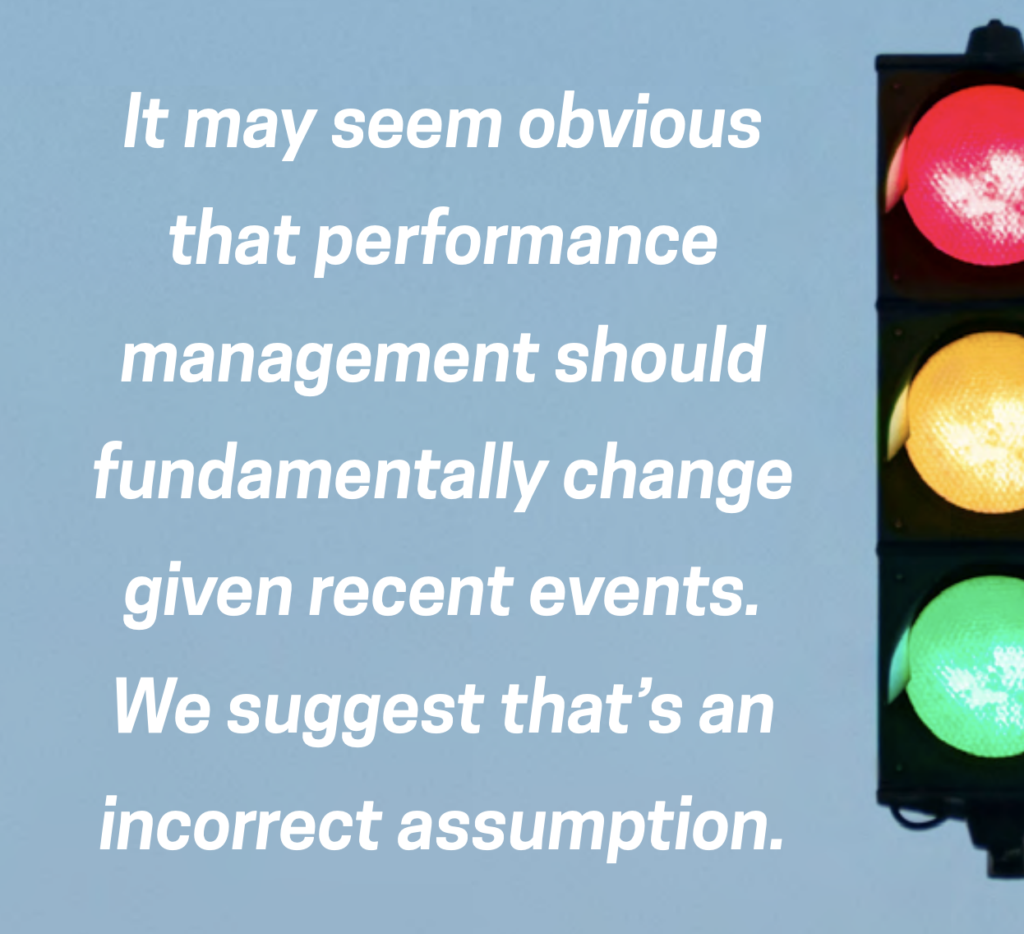
Your company’s choice about if, and how, you should execute performance management this year can be best evaluated by placing your company into one of three broad categories.
A) Damaged: Your company is in an industry that has suffered severe, long-term damage from the global shutdown. It will not recover or be on a clear path to recovery by the end of this year. Industries in this category may include airlines, hotels, restaurants, entertainment/leisure, conferences and others whose economic viability necessitates that people be in close proximity to each other.
B) Challenged: Your company temporarily lost a meaningful percentage of its revenue, but it will be able to largely return to business as usual in 2021, even if with reduced revenue. Industries in this category may include manufacturers, portions of retail, professional services firms, and energy (oil and gas), among others.
C) Fortunate: There are some industries that either experienced little impact or actually thrived during the shutdowns. These include firms in health care and pharmaceuticals, technology and telecommunications, financial services, select consumer products and the transportation/delivery services associated with them.
Note that these categories reflect the specific impact of the global shutdown, not any systemic weaknesses that preceded it. For example, if your company is in brick-and-mortar retail, your business was likely already challenged before the shutdown.
The categories also don’t factor in the common challenges that every industry suffered with the forced shift to working from home for most white-collar workers.
Companies in any of these categories need to answer two fundamental questions related to performance management: 1) How and if they should adjust goals and, 2) How and if they should adjust how they evaluate and reward employees. How to manage ratings is a frequently asked question that we’ll address that later in this article.
Our guidance for companies in each category is:
Category A: Damaged
It’s an “all bets are off” situation for Category A companies. They’ll need to restart their goal process and likely adjust the what/how balance when they evaluate results.
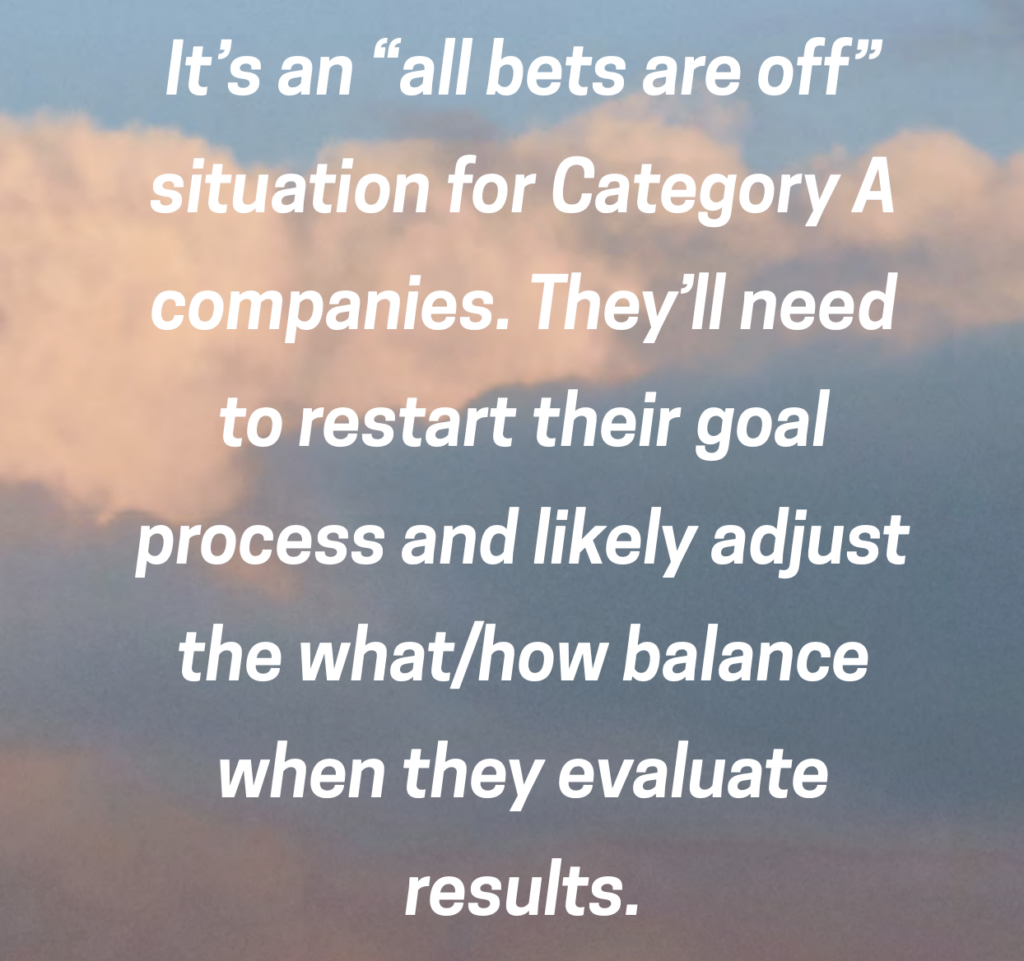
Goals
It’s likely that almost no goals set at the beginning of this year are relevant except for fundamental operating standards (safety, quality, etc.). Category A companies may not have clarity about what’s realistic to accomplish in this year, but they still need to identify the 2 – 3 focus areas for every employee, even if those goals are only set in 30-day increments. This will focus attention on what matters most and provide the clarity and certainty that so many employees crave.
If longer-term goals aren’t possible, Category A companies should also consider increasing their focus on the few critical behaviors needed to sustain the organization. This means communicating in direct, simple language the three behaviors that matter most for the firm’s survival.
This emphasis on behaviors will reinforce that, even if little can be done to advance the business, everyone should act in ways that support the culture, engage the people and maximize delivery of what is possible today. These behaviors need to be reinforced in the company’s evaluation process, as we describe below.
Evaluation and Rewards
Metrics for goal achievement at Category A companies should still exist but managers need to be flexible in how they evaluate those newly set goals. The new goals may have been set without a proper cascade, which means their ultimate contribution might not be as large as intended. They may also have been set based on assumptions at one point in time which, in a fluid global scenario, may not prove to be correct at year-end.
This doesn’t mean that managers should be sloppy when they evaluate performance. It does suggest, however, that if the revised goal was to produce 25 widgets and the individual produced 24, some consideration of the unpredictable environment is warranted.
If your company increases its focus on behaviors, it may want to increase the relative weighting of behaviors in reviews. There is no ideal balance, but 75% behaviors and 25% delivery may be appropriate for this performance cycle. This balance shouldn’t be formulaically determined but should influence the relative balance of the review conversation.
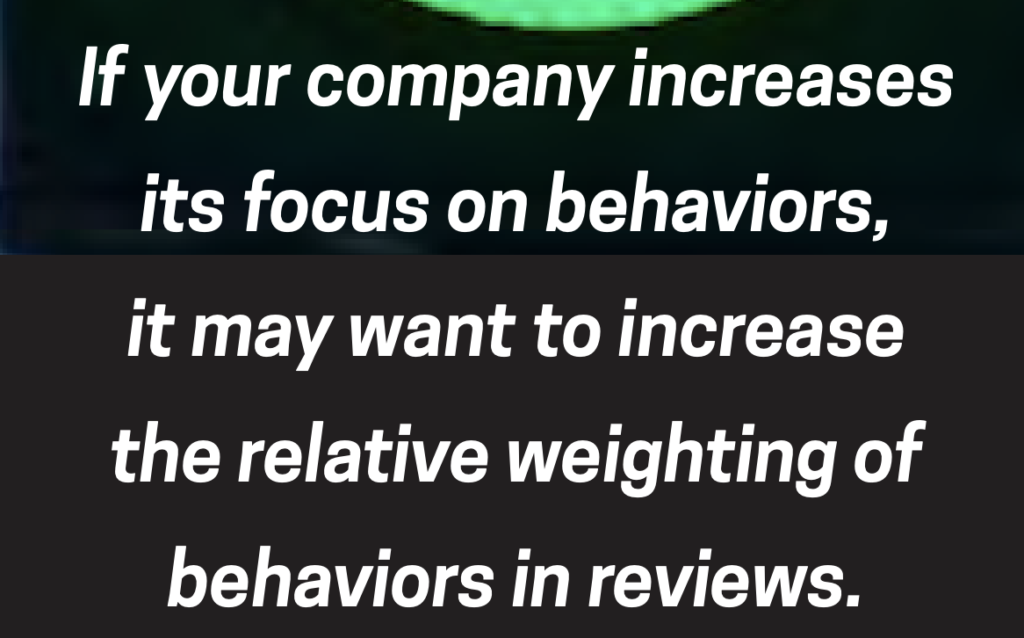
The bonus pool, if any, in Category A companies is likely to be a fraction of what it once was. Any incentive payments will be more symbolic than substantive. Think broadly about how to recognize and reward both individually and collectively. Individual rewards could include free, but highly valuable experiences and exposure, like time with senior executives, access to important meetings or high-profile developmental projects.
There is always some cash that can be allocated to bonus payments, and we’d suggest that anything distributed be highly targeted to those few employees at each level who truly out-performed.
Perhaps the more valuable rewards in Category A companies will be collective experiences that recognize the shared sacrifice of their employees. This might be a virtual awards lunch, a story video that highlights the sacrifices made and the small victories won or a virtual “thank you” session where the CEO invites the families of her/his employees to hear a live, personal message from them.
What The Performance Review Conversation Sounds Like (In Brief)
“It’s been a terrible year and we’re happy that you’re here and contributing to the business. During this time, you were able to deliver above reasonable expectations/deliver what we asked/tried hard to contribute.
We asked every employee to display our three key behaviors and you did that/tried hard to do that. As you know, we don’t have/only have a limited bonus pool. Here is what we can do for you . . .”
Category B: Challenged
These companies need to walk the fine line between adjusting goals where warranted and giving a free-pass where existing goals are still valid.

Goals
Challenged companies also need to reevaluate goals but should not assume that a challenged year means that previously set goals don’t apply. They should start by evaluating if any goals are now completely irrelevant or not applicable. For example, if a goal involved building a new factory that now won’t be built, it’s easy to replace that goal or eliminate it.
But many goals may still be very applicable and not need to be changed, especially if the metric can be adjusted. Let’s say an employee’s goal was to sell $500K of widgets but the market for widgets disappeared for four months. If there is still a market for widgets, the employee still has a widget sales goal, but you may recalculate that $350K is now an appropriate metric.
A goal to achieve a specific project might remain the same, but have the due date extended and year-end measurement changed to “appropriate progress against the goals.” For example, if an employee’s goal was to install a new enterprise software application by November, you may move the due date to March but measure in December if the project plan is on-track for a successful March launch.
It’s likely that other goals that were originally set remain valid and shouldn’t be changed.
Evaluation and Rewards
An alternative to changing goals or metrics is to keep the goal the same but to adjust the link to rewards so that partial or lower goal achievement is better recognized. For the widget salesperson, the original bonus structure might not have paid out for 70% goal achievement, but an adjusted payout structure could.
This means that the person would not achieve the goal but would receive a larger payout than they would have in the original bonus plan design. As with Category A companies, the relative impact of behaviors in reviews could be increased in firms where many goals are no longer valid and it’s difficult to accurately predict the long-term environment.
There’s likely no need to fundamentally change the review conversation at Category B companies. There will be goals that are unchanged, potentially some new goals and goals where more interpretation is allowed in evaluating results. Those goals should all fit into the existing framework for review conversations.
What The Conversation Sounds Like
“It was a challenging year and we appreciate your keeping your focus on high performance and great behaviors despite these challenges. As you know, we’ve adjusted your goals and metrics where that made sense to ensure you had the opportunity to deliver great results. Let’s talk about how you did.”
Category C: Fortunate
There are a surprisingly large number of companies who made it through the shutdowns with little or no significant financial loss. These companies need to manage expectations for evaluating performance in a strong year that they had no part in creating.
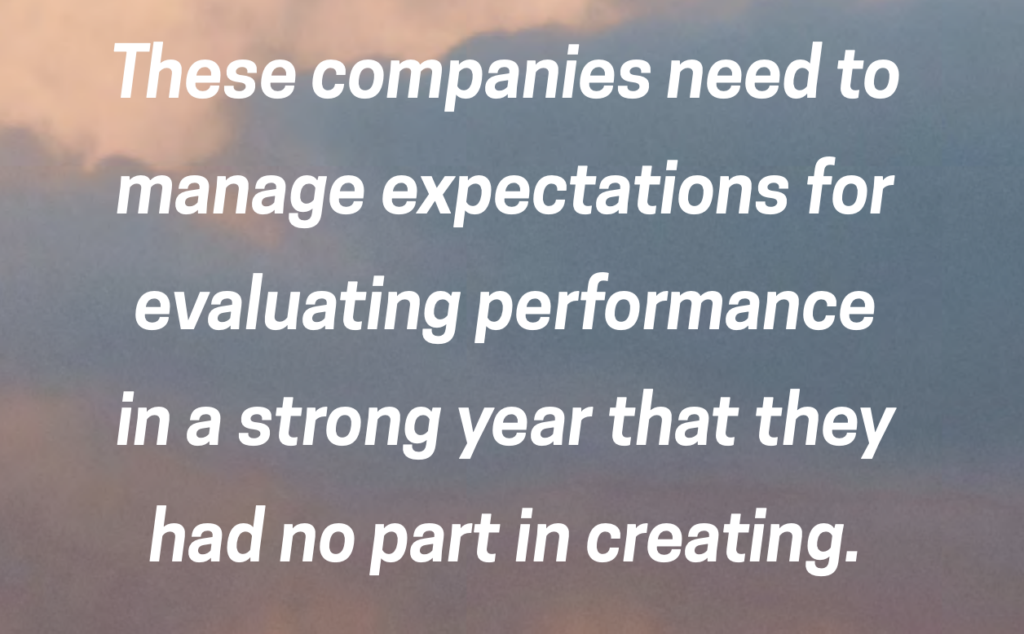
Goals
Even in companies that were relatively unaffected or positively affected by the shutdowns, goals still need to be reviewed to ensure they’re aligned with new market realities and customer demands. This may mean increasing goals or metrics in some areas where much higher results are now possible.
Evaluation and Rewards
Similar to the recommendation for Category B companies, Category C companies may want to revise the link to rewards to recognize that an individual’s results were lifted due to no unique effort on their part. This means that achieving 140% of target may not earn the reward that would normally be distributed at that performance level.
Companies can also take any additional bonus pool funding provided by strong overall results and distribute it to the highest performing and highest potential leaders.
Ratings and Reviews – What Not To Do
The HR function had just escaped from its misguided, 5+ year discussion about performance ratings when the crisis brought it back into vogue. “If Facebook could give everyone the same rating, doesn’t that show how useless ratings are?”, a client asked us. Another client mentioned that the anti-rating forces in his organization were trying to use the crisis to re-surface their agenda.
As we stated in our seminal article, We Love Ratings, performance ratings are neither universally good nor universally bad. They are simply a tool that helps to differentiate performance and force tough discussions. However, we also cited in our article After The Storm, studies by Gartner and the Center for Effective Organizations at USC that found companies without ratings had worse outcomes on key people metrics including the quality of performance conversations, frequency of performance conversations and employee engagement.
Given the opportunism of ratings opponents, we want to advance a few strong pieces of advice:
- No blanket ratings: Everyone in your company will not perform at the same level this year. Therefore, there is no reason to give everyone in your company the same rating. It’s better to delay evaluations until you’re ready to accurately rate employees than to pretend that no employee contributed more than another employee.
- Don’t eliminate ratings: Unless your company had already agreed to do this before the crisis, there is nothing about short-term economic pain that should change your mind. Especially in a moment with so much uncertainty, ratings can provide employees with needed clarity.
- Don’t change the rating scale (unless you make it simpler): Your organization doesn’t need to absorb any other changes this year. But, a simpler, broader rating scale could be highly valuable for Category A and B companies where individual results may be difficult to finely differentiate. It will be much easier for managers to sort employees’ performance into three broad categories – especially with a 10/80/10 distribution – than to have them argue about the finer points of the middle 80%.
- Don’t eliminate performance reviews: These conversations are valuable opportunities for managers and employees to have direct conversations about the most important topic – the employee’s success. Even if bonuses or merit increases aren’t awarded, this can be an “appreciation” conversation and a “let’s get focused on next year” conversation.
How To Manage The Most Important Issue
A technical discussion about performance management isn’t meant to ignore that this year has been incredibly difficult and highly emotional for many people. Families worldwide have suffered trauma in the form of lost jobs, lost income and the deaths of family members or friends.
Even those who directly escaped those tragedies have had their lives turned upside down – quarantined, overwhelmed – unable to live anything that approached a normal life.
How should your performance evaluation consider the single mother who had to perform her job with three school-age children trying to learn at home? The employee who became clinically depressed because of forced quarantine? The leader who couldn’t visit his ailing parents?
This year will need to be a year where the crisp lines of meritocracy are balanced with the unique challenges that individuals have faced. You can best support your managers in the process with clear guidance for how to (re)set goals, measure results and apply latitude in both.
1) https://www.wsj.com/articles/facebook-gives-employees-extra-1-000-and-good-reviews-amid coronavirus-11584464623
2) https://www.businessinsider.com/google-delays-employee-performance-reviews-promotions-covid-19-2020-3
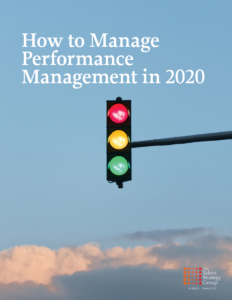
More About The Author:
- Marc Effron, President, Talent Strategy Group
- Marc founded and leads The Talent Strategy Group and consults globally to the world’s largest and most successful corporations. He co-founded the Talent Management Institute and created and publishes TalentQ magazine. He co-authored the Harvard Business Review Publishing best-seller One Page Talent Management and 8 Steps to High Performance.




